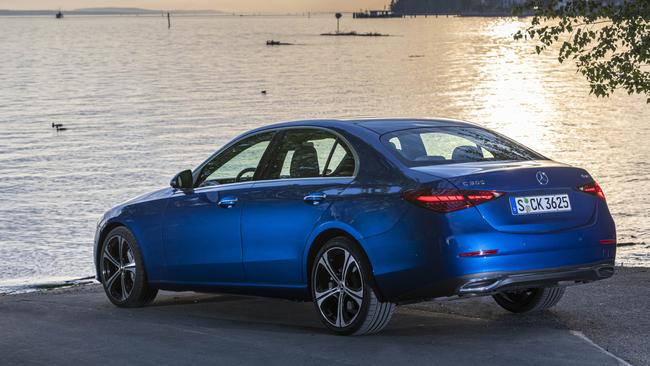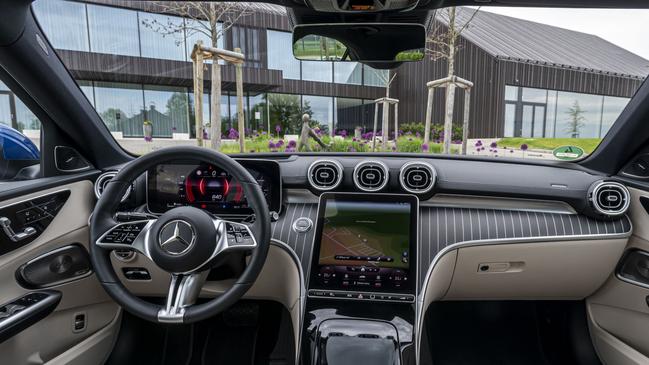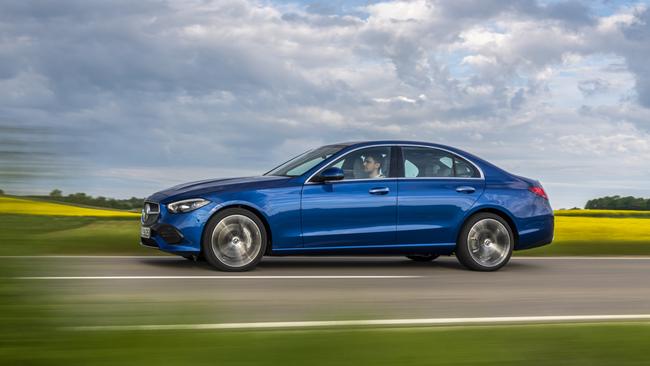2021 Mercedes-Benz C-Class review: Is this the end of the petrol engine?
This luxury car has been at the top of its game for the past decade, but a huge change is about to alter it forever.

Luxury
Don't miss out on the headlines from Luxury. Followed categories will be added to My News.
There’s a lot of S-Class in the new C-Class, but not quite enough.
Inside and out, it looks a lot like the large limo that’s the flagship of the Mercedes-Benz sedan line-up. It features much of the same advanced safety, driver assistance and infotainment technology, too.
It’s driving the C-Class that shatters the shrunk S-Class illusion. While it manages a fair imitation of the serene flotation-tank ride comfort of the much more costly S-Class, some of its engines are as charmless as those in the cheaper A-Class.

The C-Class will go on sale in Australia in the last quarter of this year. First of the line-up to arrive will be the C200 and C300 sedans.
Under the bonnet of the C200 is a turbo 1.5-litre four, while the C300 has a turbo 2.0-litre four. Both engines feature 48-volt mild-hybrid tech to boost efficiency and, briefly, power.
Mercedes-Benz will not produce a new-generation C-Class with more than four cylinders. This is a big decision, as high-end and performance versions in the past have usually had six-cylinder or V8 engines.

But every C-Class made for every market in the world will from now on feature at the very least mild-hybrid technology.
For a step up in performance, Mercedes-Benz will offer plug-in hybrid drivetrains that add the serious kick of a powerful electric motor drawing on a big, high-voltage battery pack to the engine’s output. The C350 e plug-in is scheduled to arrive in Australia next year.
Expect prices to rise slightly compared to the current models, meaning the base-grade C200 is likely to be close to $70,000. A richer level of standard equipment is promised.

While the exterior of the new C-Class is generic Mercedes-Benz and rather bland, the car’s interior will do much to make the higher prices seem worthwhile. The instrument panel, with its big, portrait-oriented centre screen slightly skewed towards the driver, is both lovely to look at and very user friendly.
The car’s infotainment system can be updated over the air and the abilities of many of the C-Class’s sensor-based safety and driver-assistance systems have been increased.

There’s plenty of space inside the new C-Class, which is slightly longer and wider than the model it replaces. There’s room for large adults in the rear seat, though the cushion is short on under-thigh support. Boot capacity remains unchanged at a useful 455 litres and the cargo compartment floor is flat.
Mercedes-Benz has done a lot right with the new C-Class, but driving the C200 isn’t a completely classy experience. The 150kW engine sounds gravelly and performance is only adequate, even though the standard nine-speed automatic does a great job of picking gears.
In default Comfort driving mode, the suspension delivers a very cushy ride that some drivers may find a little too floaty. Switching to Sport mode quickly remedies this. As for cornering ability, the new model’s steering is more direct, but the C-Class’s safe-and-sound character remains little altered.

The 190kW C300 is a much feistier performer. Even better, its larger four is a more refined engine. It sounds better, and goes harder than the C200.
For driving pleasure, though, the C350 e plug-in hybrid beats them both. The combined maximum output of its engine and motor is higher at 230kW and it can be driven using only electricity.
The silence and smoothness of the 95kW electric motor suits the car’s “mini S-Class” aspirations. The motor has such strong low-rev torque that it starts off in second gear. And performance is good all the way up to its 140km/h limited top speed in electric mode.
With the hefty 25kW battery pack putting extra weight on the rear wheels, the ride and handling are also improved.
This latest edition of the C-Class is a fine car in some ways, but there are signs Mercedes-Benz is no longer as focused as it once was on internal-combustion excellence.
MERCEDES-BENZ C200 VITALS
Price: $70,000 (est)
Safety: Auto emergency braking, blind-spot alert, lane-keep assist, traffic sign recognition
Engine: 1.5-litre 4-cyl turbo mild hybrid; 150kW/300Nm
Transmission: 9-speed auto; RWD
Thirst: 6.6L/100km (est)
0-100km/h: 7.3 secs
Originally published as 2021 Mercedes-Benz C-Class review: Is this the end of the petrol engine?


